Columns
-
The Blue Velvet Project, #93
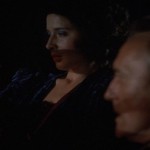
Second #4371, 72:51 As they speed towards Ben’s, Frank’s police radio suddenly bursts forth with sound and Hunter—in the passenger’s seat—picks it up excitedly and says, like a lunatic with a swamp accent, “Po-lice call! Po-lice call!” until Frank snatches the radio from him. It’s perhaps the most slapstick part of the movie, and for a moment there’s the possibility that Frank and his crew are too incompetent to hurt Jeffrey. This is the second time that Frank has uncoiled so quickly (the first happened when he suddenly grabbed Jeffrey in the hallway of Dorothy’s apartment) and within a split […]
-
4:44 Last Day on Earth — A Hammer to Nail Review
(Abel Ferrara’s 4:44 Last Day on Earth premiered at the 68th Venice Film Festival. It’s being released theatrically by IFC Films on March 23, 2012.) A number of recent films have collectively suggested that the more global, or even cosmic, the crisis, the more intimate the response. This was done most recently in Perfect Sense but also last summer’s Another Earth and, to a lesser extent, The Tree of Life, about which it might be more accurate to say that the cosmic is crafted from the intimate. (Melancholia breaks from this trend somewhat, and its cold remove is part of what makes it so disconcerting a film.) This art-house apocalypse continues in […]
-
The Blue Velvet Project, #92

Second #4324, 72:04 Frank’s 1968 Dodge Charger with pop-up headlamps, stretching the screen horizontally as far as it will go. There are three in the front of the car, and three in the back including Jeffrey, who is riding bitch. They are tearing through the night, towards Ben’s, where, in an act of dark magic, Frank will literally disappear from the screen. But before that, there’s the journey that begins with a cut that takes us from the hallway of Dorothy’s apartment to the frame above, at second #4324. The shot breakdown over the next roughly 30 seconds proceeds like […]
-
THE MICRO-BUDGET CONVERSATION: SXSW AND ITS EMOTIONAL TOLL
I am not cut out for big festivals…film or otherwise. Let’s take away the fact that large crowds disturb my calm, on top of that I am a person of extremes. I either jump in all the way, or abstain from the activity entirely. Take a person like that and just feed them beer and films…and you get the worn-out mess that is myself. Two days after the experience I’m still sick, tired, and working hard to gain a foothold on what the festival meant to me and what it means to our industry. Industry is a great place to […]
-
The Blue Velvet Project, #91
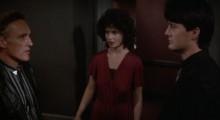
Second #4277, 71:17 1. This is the first time that Frank, Dorothy, and Jeffrey appear together in the same frame. 2. “Oh, you’re from the neighborhood,” Frank says. “You’re a neighbor. Well what’s your name neighbor?” 3. The ratings for “Mister Rogers’ Neighborhood” peaked in 1985, the year before Blue Velvet was released. 4. It’s not only Frank’s eyes that terrify, but his voice, tinged with sarcasm, delivered in Dennis Hopper’s flat, Midwestern accent. And then, buried in the soundtrack, there’s a low, faint rumbling, like the sound of thunder arriving from hundreds of miles away, having crossed vast, empty […]
-
The Kid with a Bike — A Hammer to Nail Review
(Jean-Pierre and Luc Dardenne’s The Kid with a Bike premiered at the 2011 Cannes Film Festival, where it shared the Grand Prix with Once Upon a Time in Anatolia. It is being released theatrically by Sundance Selects on 03.16.12.) The Kid with a Bike is propelled by eruptive moments nestled between long stretches of calm. That it is seen through the eyes of a child too young and confused to understand as much about himself as the viewer does would appear to make the eponymous bicycle rider’s case an ironic one, but it mostly just makes it sad. Every time […]
-
The Blue Velvet Project, #90
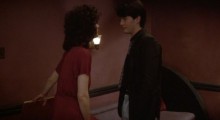
Second #4230, 70:30 In Roberto Bolaño’s short story “Days of 1978” (from the collection Last Evenings on Earth) one of the characters, upon hearing the voice of another character, suddenly and frightfully develops an unsettling and inexplicable image in his mind: It [the voice] conjures up a silent black-and-white film in which, all of a sudden, the characters start shouting incomprehensibly at the top of their voices, while a red line appears in the middle of the screen and begins to widen and spread. What to make of this? It’s nightmarish, but why? Perhaps it’s because what’s described is difficult […]
-
The Blue Velvet Project, #89
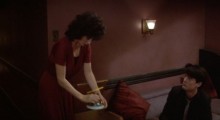
Second #4183, 69:43 In a passage from his 1952 essay “In Defense of Mixed Cinema,” André Bazin seems to predict the future, a future of watching movies in an age of interruptions and distractions. Bazin writes about watching Les Vampires (Louise Feuillade, 1915) during a night full of technical mishaps: That night only one of the two projectors was working. In addition, the print had no subtitles and I imagine that Feuillade would have had difficulty in trying to recognize the murderers. It was even money as to which were the good guys and which the bad. So difficult was […]
-
Lady Vengeance: Andrzej Zulawski – High End Low Life
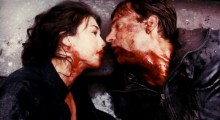
In a fit of extreme ballsiness, BAMcinématek is currently plummeting down the rabbit hole opened by Polish filmmaker Andrzej Zulawski, showcasing a complete retrospective appropriately entitled Hysterical Excess. Zulawaski’s films employ many hallmarks of genre filmmaking: the paranormal, the psychedelic, blood and guts. As well, beasties and boobies make appearances somewhat to excess, a tendency which has kept him from recognition as an “important” auteur despite a consistent aesthetic based on exhilarating camerawork (in collaboration with beloved cinematographer Andrzej Jaroszewicz) that swoops and dives like a bat one moment only to penetrate a bedroom with the tightest, most controlled zoom […]
-
The Blue Velvet Project, #88

Second #4136, 68:56 After Jeffrey strikes Dorothy, a roar of flames fills the frame. The barely repressed brute logic of the film finally explodes on the screen, as Jeffrey has, at last, become a surrogate Frank. What’s remarkable about the scene is how it’s fashioned from some pretty regressive clichés about abuse, especially in how Dorothy literally “asks for it.” On one level, Blue Velvet’s depiction of women is deformed in the worst possible ways, as it balances Sandy as the objectified virginal “good” girl, full of nurturing love, and Dorothy as the madwoman whore. There’s nothing in between, and […]
